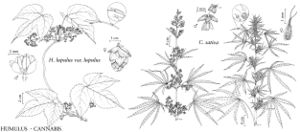Cannabis sativa
Sp. Pl. 2: 1027. 1753.
Staminate plants usually taller, less robust than pistillate plants. Stems 0.2-6 m. Leaves: petioles 2-7 cm. Leaflet blades mostly 3-9, linear to linear-lanceolate, 3-15 × 0.2-1.7 cm, margins coarsely serrate; surfaces abaxially whitish green with scattered, yellowish-brown, resinous dots, strigose, adaxially darker green with large, stiff, bulbous-based conic hairs. Inflorescences numerous. Flowers unisexual, often transitional flowers and flowers of opposite sex developing later. Staminate flowers: pedicels 0.5-3 mm; sepals ovate to lanceolate, 2.5-4 mm, puberulent; stamens caducous after anthesis, somewhat shorter than sepals; filaments 0.5-1 mm. Pistillate flowers ± sessile, enclosed by glandular, beaked bracteole and subtended by bract; perianth appressed to and surrounding base of ovary. Achenes white or greenish, mottled with purple, ovoid, somewhat compressed, 2-5 mm, with ± persistent perianth that sometimes flakes off. 2n = 20.
Phenology: Flowering early summer–fall; staminate plants generally dying after anthesis, pistillate plants remaining dark green, persisting until frost.
Habitat: Well-manured, moist farmyards, and in open habitats, waste places (roadsides, railways, vacant lots), occasionally in fallow fields and open woods
Elevation: 0-2000 m
Distribution

Introduced; principal naturalized range (see map) Ont, Que., Ark., Conn., Del., Ill., Ind., Iowa, Kans., Ky., Maine, Md., Mass., Mich., Minn., Mo., Nebr., N.H., N.J., N.Y., N.Dak., Ohio, Okla., Pa., R.I., S.Dak., Vt., Va., W.Va., Wis., native to Asia
Discussion
Cannabis sativa has been reported as cultivated illegally and as apparently ruderal in all provinces and states except Alaska. It has been collected least frequently in Mississippi and Idaho. It seems to be best established in the prairies and plains of central North America.
Hemp is a short-day plant; flowering depends upon the latitude of origin. Races originating closer to the equator (and generally higher in psychointoxicant) require a longer induction period for flowering than races originating farther north.
The taxonomy of Cannabis sativa, a polymorphic species, has been debated in scientific and legal forums. The name C. sativa subsp. indica (Lamarck) E. Small & Cronquist has been applied to plants with a mean leaf content of the psychotomimetic (hallucinatory) delta-9-tetrahydrocannabinol of at least 0.3%; those with a lesser content fall under C. sativa subsp. sativa. When separate species are recognized, the name C. indica Lamarck has generally been applied to variants with high levels of the intoxicant chemical, whereas the name C. sativa Linnaeus, interpreted in a restricted sense, has generally been applied to plants selected for their yield of bast fibers in the stems. (The latter generally have taller, hollow stems with longer internodes and less branching than races selected for drug content.)
Superimposed on this dimension of variation is selection for nonabscising achenes in cultivation and abscising achenes in the wild (i.e., outside of cultivation). This is analagous to selection of nonshattering cereals from wild, shattering grasses. Achenes selected for cultivation tend to be longer than 3.8 mm and lack a basal constricted zone; by contrast, achenes selected for wild existence tend to be shorter than 3.8 mm and to have a basal constricted zone that seems to facilitate disarticulation and a mottled, persistent perianth apparently serving as camouflage.
Within Cannabis sativa subsp. sativa, the wild phase has been named C. sativa var. spontanea Vavilov (= C. ruderalis Janishevsky), in contrast to the domesticated C. sativa var. sativa. Within C. sativa subsp. indica, the wild phase (not to be expected in North America) has been designated C. sativa var. kafiristanica (Vavilov) E. Small & Cronquist, as distinct from the domesticated C. sativa var. indica. The chemical and morphologic distinctions by which Cannabis has been split into taxa are often not readily discernible, appear to be environmentally modifiable, and vary in a continuous fashion. For most purposes it will suffice to apply the name Cannabis sativa to all plants encountered in North America.*
The Iroquois used Cannabis sativa medicinally to convince patients that they had recovered. They also found it useful as a stimulant (D. E. Moerman 1986).
Selected References
None.
